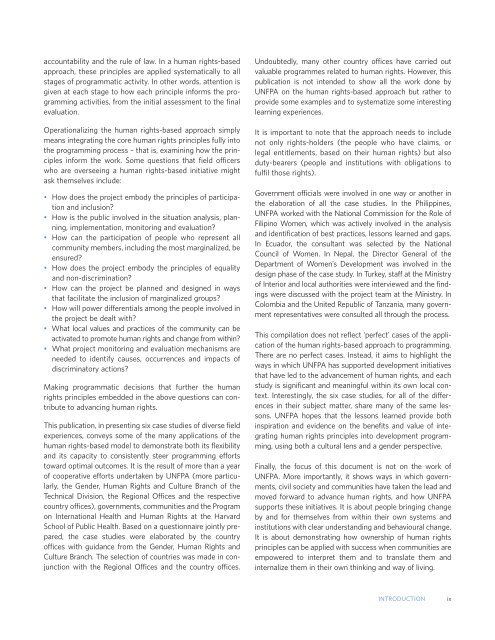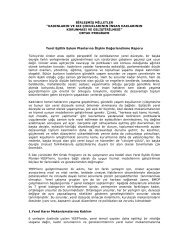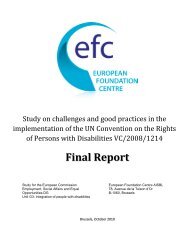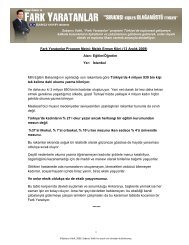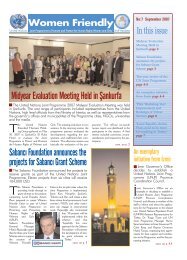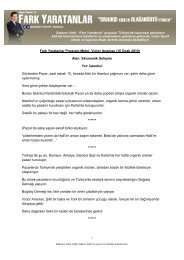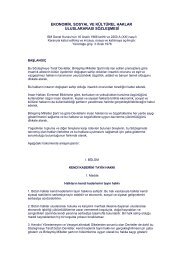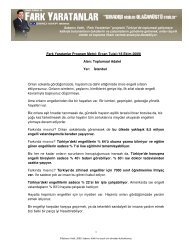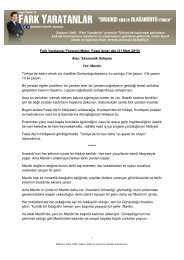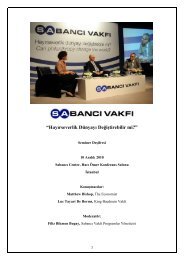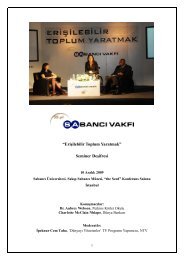UNFPA at Work: Six Human Rights Case Studies
UNFPA at Work: Six Human Rights Case Studies
UNFPA at Work: Six Human Rights Case Studies
- No tags were found...
Create successful ePaper yourself
Turn your PDF publications into a flip-book with our unique Google optimized e-Paper software.
accountability and the rule of law. In a human rights-basedapproach, these principles are applied system<strong>at</strong>ically to allstages of programm<strong>at</strong>ic activity. In other words, <strong>at</strong>tention isgiven <strong>at</strong> each stage to how each principle informs the programmingactivities, from the initial assessment to the finalevalu<strong>at</strong>ion.Oper<strong>at</strong>ionalizing the human rights-based approach simplymeans integr<strong>at</strong>ing the core human rights principles fully intothe programming process – th<strong>at</strong> is, examining how the principlesinform the work. Some questions th<strong>at</strong> field officerswho are overseeing a human rights-based initi<strong>at</strong>ive mightask themselves include:• How does the project embody the principles of particip<strong>at</strong>ionand inclusion?• How is the public involved in the situ<strong>at</strong>ion analysis, planning,implement<strong>at</strong>ion, monitoring and evalu<strong>at</strong>ion?• How can the particip<strong>at</strong>ion of people who represent allcommunity members, including the most marginalized, beensured?• How does the project embody the principles of equalityand non-discrimin<strong>at</strong>ion?• How can the project be planned and designed in waysth<strong>at</strong> facilit<strong>at</strong>e the inclusion of marginalized groups?• How will power differentials among the people involved inthe project be dealt with?• Wh<strong>at</strong> local values and practices of the community can beactiv<strong>at</strong>ed to promote human rights and change from within?• Wh<strong>at</strong> project monitoring and evalu<strong>at</strong>ion mechanisms areneeded to identify causes, occurrences and impacts ofdiscrimin<strong>at</strong>ory actions?Making programm<strong>at</strong>ic decisions th<strong>at</strong> further the humanrights principles embedded in the above questions can contributeto advancing human rights.This public<strong>at</strong>ion, in presenting six case studies of diverse fieldexperiences, conveys some of the many applic<strong>at</strong>ions of thehuman rights-based model to demonstr<strong>at</strong>e both its flexibilityand its capacity to consistently steer programming effortstoward optimal outcomes. It is the result of more than a yearof cooper<strong>at</strong>ive efforts undertaken by <strong>UNFPA</strong> (more particularly,the Gender, <strong>Human</strong> <strong>Rights</strong> and Culture Branch of theTechnical Division, the Regional Offices and the respectivecountry offices), governments, communities and the Programon Intern<strong>at</strong>ional Health and <strong>Human</strong> <strong>Rights</strong> <strong>at</strong> the HarvardSchool of Public Health. Based on a questionnaire jointly prepared,the case studies were elabor<strong>at</strong>ed by the countryoffices with guidance from the Gender, <strong>Human</strong> <strong>Rights</strong> andCulture Branch. The selection of countries was made in conjunctionwith the Regional Offices and the country offices.Undoubtedly, many other country offices have carried outvaluable programmes rel<strong>at</strong>ed to human rights. However, thispublic<strong>at</strong>ion is not intended to show all the work done by<strong>UNFPA</strong> on the human rights-based approach but r<strong>at</strong>her toprovide some examples and to system<strong>at</strong>ize some interestinglearning experiences.It is important to note th<strong>at</strong> the approach needs to includenot only rights-holders (the people who have claims, orlegal entitlements, based on their human rights) but alsoduty-bearers (people and institutions with oblig<strong>at</strong>ions tofulfil those rights).Government officials were involved in one way or another inthe elabor<strong>at</strong>ion of all the case studies. In the Philippines,<strong>UNFPA</strong> worked with the N<strong>at</strong>ional Commission for the Role ofFilipino Women, which was actively involved in the analysisand identific<strong>at</strong>ion of best practices, lessons learned and gaps.In Ecuador, the consultant was selected by the N<strong>at</strong>ionalCouncil of Women. In Nepal, the Director General of theDepartment of Women’s Development was involved in thedesign phase of the case study. In Turkey, staff <strong>at</strong> the Ministryof Interior and local authorities were interviewed and the findingswere discussed with the project team <strong>at</strong> the Ministry. InColombia and the United Republic of Tanzania, many governmentrepresent<strong>at</strong>ives were consulted all through the process.This compil<strong>at</strong>ion does not reflect ‘perfect’ cases of the applic<strong>at</strong>ionof the human rights-based approach to programming.There are no perfect cases. Instead, it aims to highlight theways in which <strong>UNFPA</strong> has supported development initi<strong>at</strong>ivesth<strong>at</strong> have led to the advancement of human rights, and eachstudy is significant and meaningful within its own local context.Interestingly, the six case studies, for all of the differencesin their subject m<strong>at</strong>ter, share many of the same lessons.<strong>UNFPA</strong> hopes th<strong>at</strong> the lessons learned provide bothinspir<strong>at</strong>ion and evidence on the benefits and value of integr<strong>at</strong>inghuman rights principles into development programming,using both a cultural lens and a gender perspective.Finally, the focus of this document is not on the work of<strong>UNFPA</strong>. More importantly, it shows ways in which governments,civil society and communities have taken the lead andmoved forward to advance human rights, and how <strong>UNFPA</strong>supports these initi<strong>at</strong>ives. It is about people bringing changeby and for themselves from within their own systems andinstitutions with clear understanding and behavioural change.It is about demonstr<strong>at</strong>ing how ownership of human rightsprinciples can be applied with success when communities areempowered to interpret them and to transl<strong>at</strong>e them andinternalize them in their own thinking and way of living.INTRODUCTIONix


